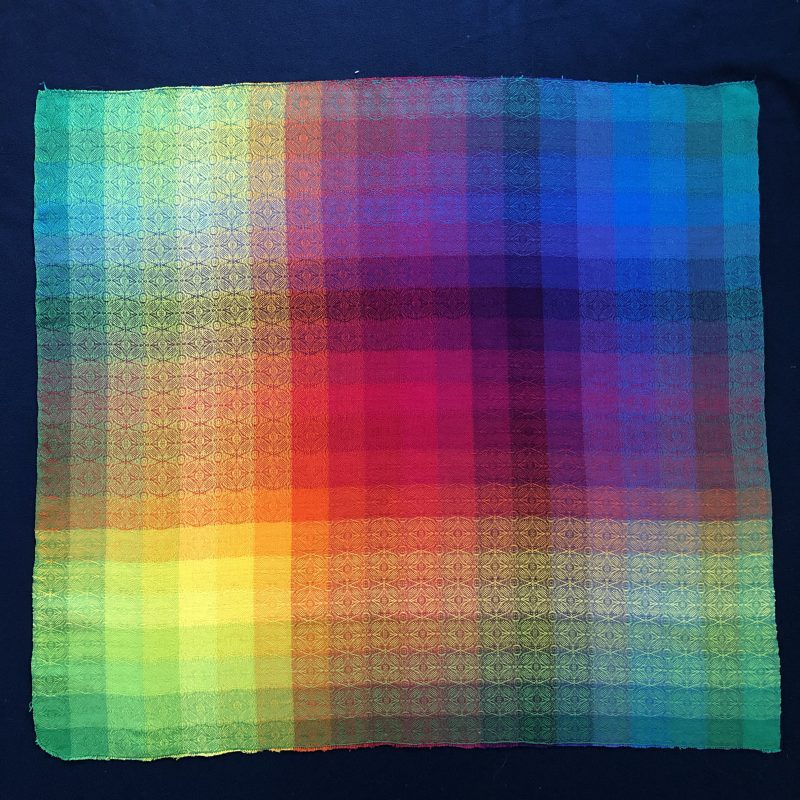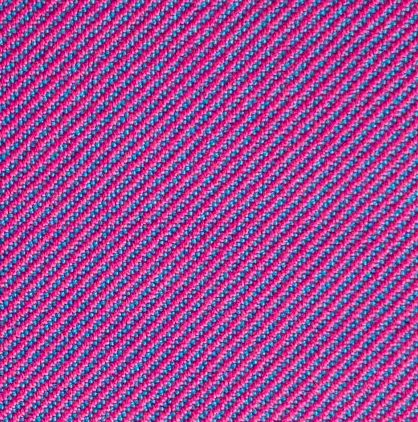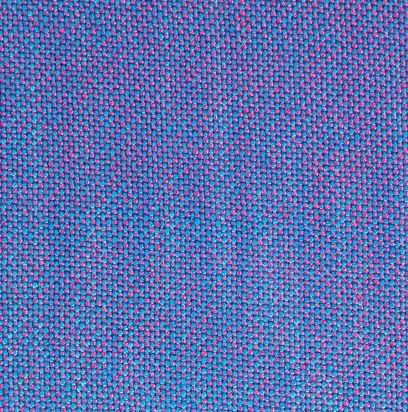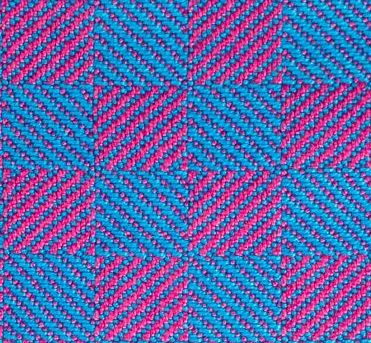Color gamps are often recommended as a tool for learning about color mixing in weaving. Unfortunately, color gamps are an expensive way to learn about color, and they have some pitfalls that most weavers aren’t aware of. This post explains how to avoid those pitfalls and use color gamps to their best advantage. It also suggests some more efficient, less expensive tools for learning about color mixing in weaving.
What’s a color gamp?
If you’re not familiar with a color gamp, it’s basically a piece of cloth that’s meant to sample color combinations. You wind your warp with stripes of several colors, then weave the cloth with stripes of different weft colors, so you can see what happens when each of the warp colors mixes with each of the weft colors using the draft you’ve chosen for the color gamp.
Traditionally, you use the same colors in warp and weft, so your finished color gamp might look like this:

Color gamps are meant to teach you about color mixing: What happens when you cross Color A with Color B when weaving. By using stripes of color in warp and weft, you can sample many color combinations in a single piece of fabric, very efficiently.
What’s a color gamp good for?
Color gamps are great for showing you how colors mix. If you want to know how the colors of the rainbow will mix when combined in equal proportions, a plain weave color gamp will show you that. Similarly, weaving a gamp in 1/3 twill will teach you how colors mix in 1:3 and 3:1 proportions (because the back of a 1/3 twill is a 3/1 twill).
Color gamps are also great for showing you how colors will mix in the weave structure used for the gamp. So if you weave a lot of plain weave, a plain weave color gamp in your favorite colors is a great tool. It will let you predict how your favorite colors will mix when crossed.
What are the limitations of a color gamp?
Color gamps do have significant limitations. The biggest one is that while they will teach you how colors combine in the abstract, they are not a good tool for predicting how colors will combine in your handwoven projects. Unless you are using the same structure and the same colors, a color gamp will not tell you how your colors will combine in your handwoven project.
The reason a color gamp won’t tell you how your colors will combine unless you use the same structure and colors is because color mixing depends on both the colors and on the draft that combines them. Change the draft, and you change the proportions and pattern in which the warp and weft colors combine. Consider these three swatches, which all use turquoise warp and magenta weft, but use different drafts:



Despite using the same colors, the different drafts result in very different-looking fabrics!
So a plain weave color gamp will teach you how turquoise and magenta look when blended in plain weave, but it won’t tell you what happens when you weave them together in a different weave structure.
As a result, color gamps won’t accurately predict your results in a woven project, unless you use the same weave structure and similar colors to the ones you will use in your actual weaving.
Color gamps are also expensive to create, both in time and materials. To create a color gamp, you need to use small amounts of many different yarns. Unless you’re purchasing a gamp kit or working from stash, you’ll need to buy many cones of yarn. And then you’ll need to wind and weave a project with many different warp and weft colors. So gamps are costly in materials, money, and time!
How to make the best use of a color gamp
Despite their limitations, color gamps can still be quite useful if you use them strategically. Here are some tips to get the most out of a color gamp:
- Use colors that you like and will use often. Color gamp kits are usually sold in rainbow colors. These produce pretty projects and will teach you what happens when you cross bright yellow with red, blue, purple, and orange (among others), but if you don’t use those colors in your weaving, the knowledge won’t do you much good. Color gamps are basically sets of color samples, so you’ll get the most out of them if you weave them in your favorite colors and yarns.
- Use a draft that looks like the ones you like and use most often. For example, if you frequently use shadow weave, choose a shadow weave draft or some other draft that alternates light/dark threads, such as log cabin. The idea is to use a draft that blends colors in about the same patterning and proportions as the drafts that you most commonly use. That way your color gamp will give you a rough idea of what your finished cloth will look like, even if it isn’t the exact same pattern.
- Make the patches of each color big enough to really see the color blends. It’s tempting to make each warp and weft stripe teeny-tiny to squeeze in as many colors as you can. But because your perception of a color is shifted by the colors that surround it, making the patches of color too small prevents you from seeing the colors accurately. Make the squares of color at least 2 inches on a side, larger if you can. Yes, this will limit the number of colors you can sample. But your color samples will be more accurate.
- When looking at your color gamp, isolate each color sample by taking two L-shaped pieces of gray paper/cardboard (or something else neutral in color) and framing the color sample with the gray paper. This will keep adjacent samples from “contaminating” the color you’re looking at.
Alternatives to color gamps
Color gamps are useful tools for exploring color, but because they are expensive and time-consuming, they are rarely the most efficient way to sample colors for a specific project. And there are now some more efficient ways to explore color, too.
You can use weaving software to simulate yarn colors in a specific draft. Desktop weaving software is useful because it allows you to see the entire draft at once. Handweaving.net also has a Color Editor (with subscription) that lets you select colors from photos of your yarn. If you have a tablet, iWeaveIt is an inexpensive alternative to desktop weaving software.
Weaving software is not perfect, because colors on the screen are not the same as colors in real life. But it is much quicker, and in most cases will give good-enough results.

I have said before that I am very confused with colors. I cannot adjust them into my appeal. I feel very silly woman. I have always had clouds into my head. There had been moments of illuminations but they did not last, , they were of a very short interval. I feel very confused with all, , with poems I read, with ideas I come across, with everything. It seems all to be so vague and uncertain. Maybe because I did not study to be a scientist. I did soft sciences. Maybe for this. I must deal with the fact that I am a silly woman. So what ? Everybody cannot pass over the other side of the river.
Keep reading, Despina! I am of the firm belief that everyone can understand color. If you read my other blog posts they explain how color works…and if you take my courses they will help you understand how color works. I have a free mini-course that may help…just click on “Classes” in the menu bar.
Don’t give up!
Tien
That plain weave sample is probably iridescent- would like to see a picture of it “crinkled”.